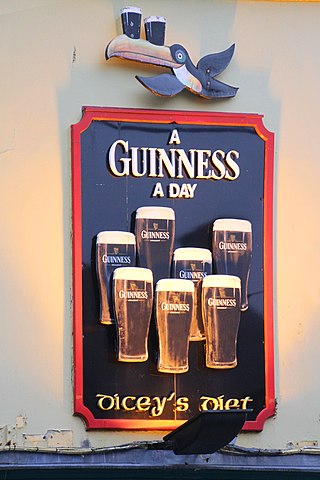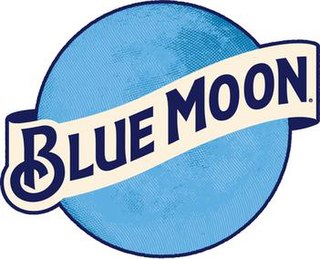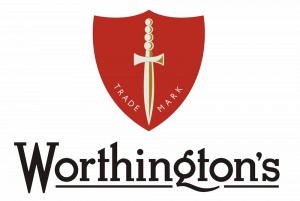
Pale ale is a golden to amber coloured beer style brewed with pale malt. The term first appeared in England around 1703 for beers made from malts dried with high-carbon coke, which resulted in a lighter colour than other beers popular at that time. Different brewing practices and hop quantities have resulted in a range of tastes and strengths within the pale ale family.

India pale ale (IPA) is a hoppy beer style within the broader category of pale ale.

Bass Brewery is a British brewer founded in 1777 by William Bass in Burton-upon-Trent, Staffordshire, England. The main brand was Bass Pale Ale, once the highest-selling beer in the UK. By 1877, Bass had become the largest brewery in the world, with an annual output of one million barrels. Its pale ale was exported throughout the British Empire, and the company's iconic red triangle became the UK's first registered trade mark.

Beer was introduced to Canada by European settlers in the seventeenth century. The first commercial brewery was La Brasseries du Roy started by New France Intendant Jean Talon, in Québec City in 1668. Many commercial brewers thrived until prohibition in Canada. The provincial and federal governments' attempt to eliminate "intoxicating" beverages led to the closing of nearly three quarters of breweries between 1878 and 1928. It was only in the second half of the twentieth century that a significant number of new breweries opened up. The Canadian beer industry now plays an important role in Canadian identity, although globalization of the brewing industry has seen the major players in Canada acquired by or merged with foreign companies, notably its three largest beer producers: Labatt, Molson and Sleeman. The result is that Moosehead, with an estimated 3.8 percent share of the domestic market in 2016, has become the largest fully Canadian-owned brewer.

Beer has been brewed in England for thousands of years. As a beer brewing country, it is known for top fermented cask beer which finishes maturing in the cellar of the pub rather than at the brewery and is served with only natural carbonation.

The Granville Island Brewing Company (GIB) was a brewery originally based on Granville Island in Vancouver, British Columbia, Canada. It was founded in 1984 and calls itself "Canada's first microbrewery". In 1989, it was sold to the wine conglomerate Andrew Peller Ltd. In 2009, it was bought by Creemore Springs, a subsidiary of Molson Coors, which in 2016, became the third largest beer corporation in the world. Of brewers with locations in British Columbia, Granville is the seventh largest based on sales to the BC Liquor Distribution Branch.

Brewing in Ireland has a long history. Production currently stands at over 8 million hectolitres, and approximately half the alcohol consumed is beer.

Blue Moon Belgian White is a Belgian-style witbier brewed by Molson Coors under the name the Blue Moon Brewing Co. It was launched in 1995, and was originally brewed in Golden, Colorado.

Stones Bitter is a beer manufactured and distributed in the United Kingdom by the North American brewer Molson Coors. It is a bitter with a straw-golden hue. Stones Bitter was first brewed in 1948 by William Stones Ltd at the Cannon Brewery in Sheffield. It was designed for the local steelworkers and became successful in its local area, becoming one of Sheffield's best known products.

Terrapin Beer Company is a brewery founded in 2002 by Brian "Spike" Buckowski and John Cochran in Athens, Georgia, United States. In July 2016, Molson Coors announced its majority stake in Terrapin, ending its status as a craft brewery.

Worthington Brewery, also known as Worthington & Co. and Worthington's, is a British brewer founded by William Worthington in Burton upon Trent in 1761. It is the second oldest continuously brewed British beer brand, after Whitbread. The best known Worthington beers are its Creamflow nitrokeg bitter and White Shield India Pale Ale.

The Thornbridge Brewery is an independent brewery founded in the grounds of Thornbridge Hall in Ashford-in-the-Water near Bakewell, Derbyshire, England.

Sharp's Brewery is a British brewery founded in 1994 in St Minver Lowlands, Rock, Cornwall, by Bill Sharp. Since 2011, the brewery has been owned by Molson Coors. It is best known for its flagship ale Doom Bar, named after the notoriously perilous Doom Bar sandbank in north Cornwall.

Burton upon Trent has a long history of brewing, at one time exporting beer throughout the world and accounting for a quarter of UK beer production; emulation of Burton water in brewing is called Burtonisation. Much of the town was given over to the industry throughout the 19th century and brewers dominated it politically and socially.
Caffrey's Irish Ale is an ale launched in 1994 by Bass Brewery and currently owned by Molson Coors.

Stones Brewery was a brewery founded in 1868 by William Stones in Sheffield, West Riding of Yorkshire, England, and purchased by Bass Brewery in 1968. After its closure in 1999, its major brand, Stones Bitter, has continued to be produced by the Molson Coors Brewing Company.
Coors Brewers Limited, later known as Molson Coors Brewing Company (UK) Limited, is the UK arm of Molson Coors Beverage Company. Its headquarters is in Burton upon Trent, Staffordshire. The company originates from Bass Brewers Limited. The company has gone through many name changes and mergers.

Beer in Scotland is mostly produced by breweries in the central Lowlands, which also contain the main centres of population. Edinburgh and Alloa in particular became noted for the export of beer around the world in the 19th century.
Double Diamond Burton Pale Ale is an English pale ale, first brewed in 1876 by Samuel Allsopp & Sons. It was one of the highest selling beers in the United Kingdom in the 1950s, 1960s and 1970s.

Burton ale is a type of strong ale which is dark and sweet. It is named after the brewing town of Burton-on-Trent.

















